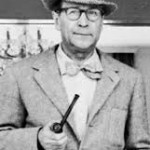Simenon’s The Mandarin Sounds Fun – but was it real?
Posted: July 11th, 2013 | 2 Comments » I recently started reading George Simenon’s non-Inspector Maigret books – after being (as it turns out) correctly educated by The New Yorker – I started with The Widow (a great read by the way). It turns out that Simenon’s non-Maigret novels are easily the equivalent of Camus. However, ever a Chinese related conundrum! Simenon has a wonderful description of a beerhall on the 1940s streets of Paris, Boulevard St. Michel on the Left Bank to be precise. This beerhall is a place for down and out and various reprobates (and students) to play cards, poker and drink as they all fall hopelessly in love with fallen women and then inevitably into debt. The joint is called “The Mandarin” – but did it exist? is it based on a real place? In his many, many novels featuring Inspector Maigret, Simenon makes much and oft use of the Boulevard St Michel and surrounding streets of the Latin Quarter, though usually for the lovely cafes rather than disreputable dive bars. I’m going to have to assume that Simenon made up The Mandarin, but if anyone knows any different then do please let me know?
I recently started reading George Simenon’s non-Inspector Maigret books – after being (as it turns out) correctly educated by The New Yorker – I started with The Widow (a great read by the way). It turns out that Simenon’s non-Maigret novels are easily the equivalent of Camus. However, ever a Chinese related conundrum! Simenon has a wonderful description of a beerhall on the 1940s streets of Paris, Boulevard St. Michel on the Left Bank to be precise. This beerhall is a place for down and out and various reprobates (and students) to play cards, poker and drink as they all fall hopelessly in love with fallen women and then inevitably into debt. The joint is called “The Mandarin” – but did it exist? is it based on a real place? In his many, many novels featuring Inspector Maigret, Simenon makes much and oft use of the Boulevard St Michel and surrounding streets of the Latin Quarter, though usually for the lovely cafes rather than disreputable dive bars. I’m going to have to assume that Simenon made up The Mandarin, but if anyone knows any different then do please let me know?

You might look at Bill Alder’s “Maigret, Simenon and France: social dimensions of the novels and stories.”
Although it may not mention The Mandarin, it’s a well-researched, well-documented, and well-written work that focuses on whether Simenon (consciously or not) presents an accurate portrait of French society.
great tip – thanks, didn’t know that book